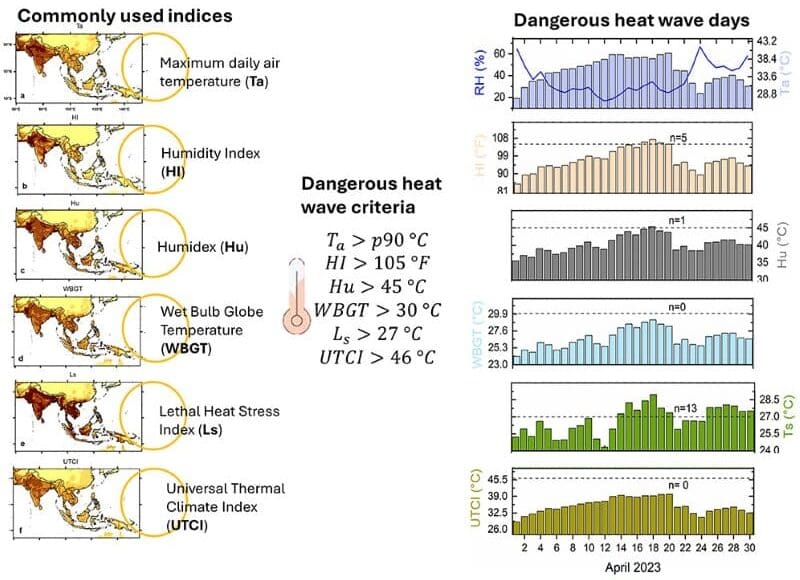By Cell Press
Even though climate change is bringing more frequent and severe heat waves, there is no standard, global way to measure heat-wave severity, and existing indices have different thresholds for defining dangerous heat-stress conditions.
Researchers report August 7 in the journal Nexus that five out of six existing heat-wave indices were unable to capture the severity and spatial distribution of recent lethal heat waves in India, Spain, and the USA. The sixth index – the lethal heat-stress index – was better able to identify dangerous heat-stress conditions, particularly in low-humidity regions.
“We found that some existing indices may not be appropriate to all geographical regions and climate conditions,” says senior author and geospatial expert Qihao Weng of the Hong Kong Polytechnic University. “It’s important that scientific communities, public health circles, and policy makers come together and reconsider the existing indices.”

Currently, countries around the world have different ways of measuring and defining heat waves, but it’s not clear which of these methods is most effective or how their performance is impacted by background climatic conditions. Some of these metrics are based purely on the maximum air temperature while others include factors such as radiation, wind, and, crucially, humidity.
“Even in relatively low-temperature conditions, if the humidity is high, it can still be dangerous for people with health problems,” says Weng. “In humid conditions, even 28°C, wet-bulb conditions can lead to severe strain and heat stroke.”
To compare the effectiveness of existing heat-wave indices under different conditions, the researchers applied six existing indices to climate data from heat waves that occurred in Spain and the United States in 2022 and in India in 2023. In all cases, they found that one method – the lethal heat-stress index – outperformed the others. Compared to the other indices, the lethal heat-stress index could differentiate between areas that were or were not impacted by extreme heat stress and could pinpoint on which days these dangerous heat conditions occurred.
The lethal heat-stress index is a temperature- and humidity-based metric for identifying conditions that are likely to lead to human death (in contrast to other indices that use endpoints such as “extreme danger” and “heat stroke imminent”). Though most of the other indices also include humidity in their calculations in some way, the way that they do this differs.
“The lethal heat stress index applies a correction factor to relative humidity, which means that it is better at predicting dangerous heat conditions in regions which have very low humid conditions compared to the other indices,” says first author Pir Mohammad, an earth scientist at Hong Kong Polytechnic University.
The researchers emphasize that heat waves are experienced differently by different people, even within the same region, because of factors including age, pre-existing health conditions, and socioeconomic status, which is associated with access to adequate cooling and the privilege of not working outdoors during hot conditions.
Though they identified the lethal heat-stress index as the best current option, the researchers say that this index could still be improved with more research.
They also note that while their study focuses on outdoor air temperatures, more heat-related mortalities occur indoors than outdoors, and future research should also address indoor conditions during heat waves and examine how they are impacted by things such as building age and materials.
Ultimately, they hope their findings will help scientists develop a universal definition of the threshold for dangerous heat conditions.
“We need to deploy a global framework that considers temperature, humidity, and other factors like socioeconomic status and age so that we can mitigate dangerous heat-wave conditions,” says Mohammad. “The UK government recently redefined their limiting criteria for heat waves, and it might be a good time for other countries to also think about how we can define heat waves more effectively.”
***
This research was supported by the Hong Kong SAR Government, the Research Talent Hub of the Innovation and Technology Fund of Hong Kong, and the Hong Kong Polytechnic University.
Journal Reference:
Pir Mohammad, Qihao Weng, ‘Comparing Existing Heat Wave Indices in Identifying Dangerous Heat Wave Outdoor Conditions’, Nexus (2024). DOI: 10.1016/j.ynexs.2024.100027
Article Source:
Press Release/Material by Cell Press
Featured image credit: wirestock | Freepik




